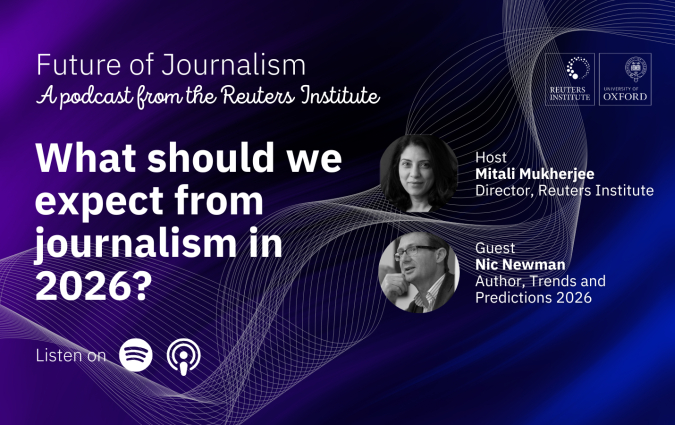Five reasons for evidence-based optimism from the Digital News Report 2023

The top line findings from the Reuters Institute Digital News Report 2023 are challenging for news publishers – the “connection” between many citizens and much of journalism is weakening, distribution continues to shift to platforms, interest and trust in news are down, news avoidance is up, and influencers and personalities command more and more attention, even when it comes to how people navigate news.
But there are also reasons for evidence-based optimism. Here are five.
1. People are increasingly relying on digital platforms, but also have multiple concerns about the implications of more personalised news
Many people are concerned about whether the news they see online is real or fake. They generally trust news in social media less than news in general, and worry that they are missing out on important information and/or challenging points of view.
Given these concerns, it is encouraging that around 65% of younger users (under-35s) and 55% of older ones (35+) have tried to influence story selection by following or unfollowing, muting or blocking, or changing other settings. Taking proactive steps to get more reliable content and/or to see more diverse perspectives are particularly widespread.
Many people want something better, and their interest in reliable content and diverse perspectives are well aligned with what many publishers would like to offer.
Public concerns about what they do and do not see on platforms is an opportunity for publishers.
2. While news avoidance is spreading in many markets, there are also clear actionable opportunities to respond
This year, 36% of our respondents say they actively avoid the news sometimes or often, seven percentage points up since 2017.
Such selective news avoidance is clearly disquieting for journalists. But our research does not only document the challenge. It also helps identify possible ways of responding to it.
It is up to journalists and editors to decide what they believe is the right course of action given their editorial mission, their funding imperatives, and their target audiences.
As they make those decisions, we hope our data identifying actionable opportunities to engage news avoiders – for example by offering at least some more positive and/or solutions-oriented coverage in addition to other kinds of journalism – will be useful.
Public interest in news that also identifies reasons for hope is an opportunity for publishers who recognise that this can fall within the commitment to seek truth and report it.
3. While general trust in news continues to erode in many countries, even in low-trust contexts, some individual brands continue to be trusted by a majority
Our top line trust question asks people whether they feel they can trust most news most of the time. This data helps capture general public opinion, as well as identify differences both between different groups within countries and across countries (whether people’s subjective judgements are aligned with underlying trustworthiness is a separate issue).
We document high levels of trust in countries such as Finland (69%) and much lower levels of trust in politically polarised countries such as Greece (19%), as well as a tendency towards a decline over time in many countries – the 46-market average is 40% this year, down another two percentage points since 2022.
This top line trust question also provides context for interpreting public perception of how trustworthy people think individual news brands are. As with the top line, these findings reflect aggregates of subjective opinions, not an objective measure of underlying trustworthiness, and are often at least as much about political and social factors as narrowly about the news itself.
The results are sometimes troubling – when many people trust brands some journalists may feel are not trustworthy, or distrust brands many expert observers respect for their reporting. However unwelcome, the data helps capture important aspects of a social reality that we have to contend with.
The brand-level results are also, however, sometimes encouraging – as we can document that, even in low-trust contexts, some individual brands continue to be trusted by a majority, including many public service media such as the BBC as well as respected independent news media operating in difficult contexts, such as El Espectador in Colombia, The Hindu and the Indian Express in India, and ABS-CBN in the Philippines.
Some respected brands’ ability to maintain majority public trust even in low trust and difficult contexts is an opportunity to stand out against a backdrop of concern over misinformation, unreliable news, and political propaganda.
4. Even in the context of a cost-of-living crisis in many countries and people re-examining their media spending, the percentage paying for online news remains stable
The business of news is facing serious challenges – offline revenues continue to decline, advertisers are moving their spend online and to platforms, and consumers may be beginning to reevaluate how many online subscriptions (not just for news) they are willing and able to take out.
Given the cost-of-living crisis, inflation, and economic weakening we see in many markets, and the continued abundant offer of news that is free to access both online and from broadcast, it is perhaps not surprising that the percentage of respondents who say they have paid for online news in the last year has not increased further in the markets where we track this over time.
But the fact that 17%, on average across 20 markets, say they do is also a glass-half-full story. In 2009, Arianna Huffington proclaimed that “the paywall is history”. Less than 15 years later, tens of millions of people pay, digital news subscriptions are a multi-billion dollar business, and many publishers have grown their reader revenues to a point where they have overtaken advertising.
If, in the recent past, many feared that there either was no sustainable business model for digital news, or that the only models that would work were premised on churnalism, clickbait, and listicles, today we may have almost the opposite problem – that the most successful business models for digital news all tend to focus on serving the (sizable) minority of affluent, highly educated, often urban, privileged and highly interested news lovers.
The documented success of publishers delivering commercial success on the basis of a distinct editorial offer and investment in effectively serving people’s needs online is an opportunity for others to learn from them.
5. While globally, across all the markets covered, platforms increasingly dominate news discovery, in some markets, news publishers retain strong direct connections
This year, we document the continued shift towards a more digital, more mobile, and more platform-dominated media environment.
Nearly everyone nearly everywhere who can afford connectivity and isn’t prevented from going online seems to be opting for various digital offers at the expense of legacy providers (even as people also have many concerns about the media they increasingly rely on).
This development has been described by scholars as “platformisation”, affecting the distribution, circulation, and production of cultural content and forms of expression. It is exceptionally challenging for news publishers, who historically have based both their societal role and their business models on controlling the means of distribution. As people go elsewhere, they no longer do.
But our data also helps document vast variations in how successful publishers in different countries have been in terms of carving out strong direct connections with the public in this incredibly competitive environment.
In countries including Finland, Norway, Sweden, Denmark, and the UK, large numbers of internet users identify going directly to a news site or app as their main way of accessing online news.
This is not because people in these markets do not use social media – the vast majority do. It is because a diverse range of news media have managed to stand out from what platforms have to offer and maintain a direct connection.
The fact that publishers in some countries with very high levels of social media use continue to have strong direct connections with much of the public document that news media can still find ways to reach people even in platform-dominated environments.
None of these findings make the wider political, economic, social, and technological challenges that journalism face go away.
But they all provide reasons for evidence-based optimism that publishers can continue to stand out, serve their needs, maintain their trust, earn their financial support, and connect with people, even in incredibly competitive and often difficult circumstances.
Explore the Digital News Report 2023
In every email we send you'll find original reporting, evidence-based insights, online seminars and readings curated from 100s of sources - all in 5 minutes.
- Twice a week
- More than 20,000 people receive it
- Unsubscribe any time






